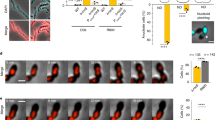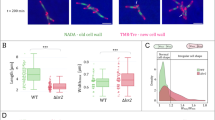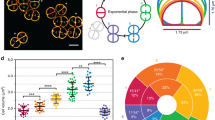Abstract
The bacterial cell cycle requires the tight regulation and precise coordination of several sophisticated cellular processes. Prominent among them is the formation of the dividing wall or septum, which has to take place at the right time and place to ensure equality of the progeny and integrity of the genome. Nucleoid occlusion is a defence mechanism that prevents the chromosome from being bisected and broken by the division septum. It does so by preventing Z ring formation near the nucleoid, which also helps to determine the location of septation.
This is a preview of subscription content, access via your institution
Access options
Subscribe to this journal
Receive 12 print issues and online access
$209.00 per year
only $17.42 per issue
Buy this article
- Purchase on Springer Link
- Instant access to full article PDF
Prices may be subject to local taxes which are calculated during checkout



Similar content being viewed by others
References
Toro, E. & Shapiro, L. Bacterial chromosome organization and segregation. Cold Spring Harb. Perspect. Biol. 2, a000349 (2010).
Adams, D. W. & Errington, J. Bacterial cell division: assembly, maintenance and disassembly of the Z ring. Nature Rev. Microbiol. 7, 642–653 (2009).
Mukherjee, A. & Lutkenhaus, J. Guanine nucleotide-dependent assembly of FtsZ into filaments. J. Bacteriol. 176, 2754–2758 (1994).
Erickson, H. P. FtsZ, a prokaryotic homolog of tubulin? Cell 80, 367–370 (1995).
Errington, J., Daniel, R. A. & Scheffers, D. J. Cytokinesis in bacteria. Microbiol. Mol. Biol. Rev. 67, 52–65 (2003).
Gamba, P., Veening, J. W., Saunders, N. J., Hamoen, L. W. & Daniel, R. A. Two-step assembly dynamics of the Bacillus subtilis divisome. J. Bacteriol. 191, 4186–4194 (2009).
Harry, E., Monahan, L. & Thompson, L. Bacterial cell division: the mechanism and its precison. Int. Rev. Cytol. 253, 27–94 (2006).
Barak, I. & Wilkinson, A. J. Division site recognition in Escherichia coli and Bacillus subtilis. FEMS Microbiol. Rev. 31, 311–326 (2007).
Lutkenhaus, J. Assembly dynamics of the bacterial MinCDE system and spatial regulation of the Z ring. Annu. Rev. Biochem. 76, 539–562 (2007).
Bramkamp, M. & van Baarle, S. Division site selection in rod-shaped bacteria. Curr. Opin. Microbiol. 12, 683–688 (2009).
Mulder, E. & Woldringh, C. L. Actively replicating nucleoids influence positioning of division sites in Escherichia coli filaments forming cells lacking DNA. J. Bacteriol. 171, 4303–4314 (1989).
Woldringh, C. L., Mulder, E., Huls, P. G. & Vischer, N. Toporegulation of bacterial division according to the nucleoid occlusion model. Res. Microbiol. 142, 309–320 (1991).
Cook, W. R., de Boer, P. A. & Rothfield, L. I. Differentiation of the bacterial cell division site. Int. Rev. Cytol. 118, 1–31 (1989).
Wu, L. J. & Errington, J. Coordination of cell division and chromosome segregation by a nucleoid occlusion protein in Bacillus subtilis. Cell 117, 915–925 (2004).
Bernhardt, T. G. & de Boer, P. A. SlmA, a nucleoid-associated, FtsZ binding protein required for blocking septal ring assembly over chromosomes in E. coli. Mol. Cell 18, 555–564 (2005).
Cho, H., McManus, H. R., Dove, S. L. & Bernhardt, T. G. Nucleoid occlusion factor SlmA is a DNA-activated FtsZ polymerization antagonist. Proc. Natl Acad. Sci. USA 108, 3773–3778 (2011).
Tonthat, N. K. et al. Molecular mechanism by which the nucleoid occlusion factor, SlmA, keeps cytokinesis in check. EMBO J. 30, 154–164 (2011).
Wu, L. J. et al. Noc protein binds to specific DNA sequences to coordinate cell division with chromosome segregation. EMBO J. 28, 1940–1952 (2009).
Veiga, H., Jorge, A. M. & Pinho, M. G. Absence of nucleoid occlusion effector Noc impairs formation of orthogonal FtsZ rings during Staphylococcus aureus cell division. Mol. Microbiol. 8, 1365–2958 (2011).
Bernard, R., Marquis, K. A. & Rudner, D. Z. Nucleoid occlusion prevents cell division during replication fork arrest in Bacillus subtilis. Mol. Microbiol. 78, 866–882 (2010).
Moriya, S., Rashid, R. A., Rodrigues, C. D. & Harry, E. J. Influence of the nucleoid and the early stages of DNA replication on positioning the division site in Bacillus subtilis. Mol. Microbiol. 76, 634–647 (2010).
Flardh, K. & Buttner, M. J. Streptomyces morphogenetics: dissecting differentiation in a filamentous bacterium. Nature Rev. Microbiol. 7, 36–49 (2009).
Willemse, J., Borst, J. W., de Waal, E., Bisseling, T. & van Wezel, G. P. Positive control of cell division: FtsZ is recruited by SsgB during sporulation of Streptomyces. Genes Dev. 25, 89–99 (2011).
Sievers, J., Raether, B., Perego, M. & Errington, J. Characterization of the parB-like yyaA gene of Bacillus subtilis. J. Bacteriol. 184, 1102–1111 (2002).
Woldringh, C. L. The role of co-transcriptional translation and protein translocation (transertion) in bacterial chromosome segregation. Mol. Microbiol. 45, 17–29 (2002).
Acknowledgements
Work in the authors' laboratory is funded by the UK Biotechnology and Biological Sciences Research Council and the European Research Council. The authors thank D. Adams for comments on the manuscript and S.Ishikawa for assisting with the preparation of the S. aureus NBS distribution map.
Author information
Authors and Affiliations
Corresponding author
Ethics declarations
Competing interests
The authors declare no competing financial interests.
Related links
Rights and permissions
About this article
Cite this article
Wu, L., Errington, J. Nucleoid occlusion and bacterial cell division. Nat Rev Microbiol 10, 8–12 (2012). https://doi.org/10.1038/nrmicro2671
Published:
Issue Date:
DOI: https://doi.org/10.1038/nrmicro2671
This article is cited by
-
CcrZ is a pneumococcal spatiotemporal cell cycle regulator that interacts with FtsZ and controls DNA replication by modulating the activity of DnaA
Nature Microbiology (2021)
-
Towards a synthetic cell cycle
Nature Communications (2021)
-
Geometric principles underlying the proliferation of a model cell system
Nature Communications (2020)
-
Structural features of the interaction of MapZ with FtsZ and membranes in Streptococcus pneumoniae
Scientific Reports (2020)
-
Reassessment of the distinctive geometry of Staphylococcus aureus cell division
Nature Communications (2020)



